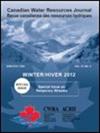利用水温增强环境流量信息:加拿大东部的案例研究
IF 1.7
4区 环境科学与生态学
Q3 WATER RESOURCES
引用次数: 1
摘要
摘要全球水需求的增加和气候变化使淡水资源和河流生态系统面临日益稀缺和用水冲突的风险。部分由于水温升高,溪流生物群可能面临日益紧张的水生栖息地条件。针对这些问题,环境流量在流量评估、水资源管理和水生生物群保护方面发挥着至关重要的作用。环境流量(eflows),也称为河道内流量要求,是指河流维持水生生态系统平衡所需的水量。最近,将河流温度纳入河流评估引起了人们的兴趣,特别是在气候变化和大坝运行的背景下,这正在改变河流的热状况并影响水生栖息地。本研究的重点是可用于规定加拿大大西洋和魁北克(加拿大东部)的流量的水文指标。流量分析与61个地点的河流温度分析共同进行。结果表明,在取水可能很重要的时期,夏季环境流量指标可能与相对较高的水温有关。因此,建议在制定径流目标之前,根据夏季枯水期的热状况对河流进行分类。本文章由计算机程序翻译,如有差异,请以英文原文为准。
Augmenting environmental flow information with water temperature: case study in Eastern Canada
Abstract The increasing global water demand and climate change put freshwater resources and riverine ecosystems at risk of increasing scarcity and conflict in water usage. Stream biota may be confronted with increasing stressful aquatic habitat conditions due in part to increasing water temperatures. In response to these issues, environmental flows play a crucial role in flow assessment, water resource management and the protection of aquatic biota. Environmental flows (eflows), also known as instream flow requirements, refer to the amount of water needed in rivers to maintain a balanced aquatic ecosystem. Recently, the inclusion of river temperature in the assessment of eflows has raised interest, especially in the context of climate change and dam operations, which are altering the river thermal regimes and affecting aquatic habitat. This study focuses on hydrological metrics that can be used to prescribe eflows in Atlantic Canada and Quebec (Eastern Canada). Eflow analyses were conducted jointly with the analyses of river temperatures at 61 sites. The results show that summer environmental flow metrics can be associated with relatively high water temperatures during a period when water withdrawals may be important. Classifying rivers according to their thermal regime during summer low flow periods prior to prescribing an eflow target is therefore recommended.
求助全文
通过发布文献求助,成功后即可免费获取论文全文。
去求助
来源期刊

Canadian Water Resources Journal
WATER RESOURCES-
CiteScore
2.90
自引率
5.90%
发文量
17
审稿时长
>12 weeks
期刊介绍:
The Canadian Water Resources Journal accepts manuscripts in English or French and publishes abstracts in both official languages. Preference is given to manuscripts focusing on science and policy aspects of Canadian water management. Specifically, manuscripts should stimulate public awareness and understanding of Canada''s water resources, encourage recognition of the high priority of water as a resource, and provide new or increased knowledge on some aspect of Canada''s water.
The Canadian Water Resources Journal was first published in the fall of 1976 and it has grown in stature to be recognized as a quality and important publication in the water resources field.
 求助内容:
求助内容: 应助结果提醒方式:
应助结果提醒方式:


